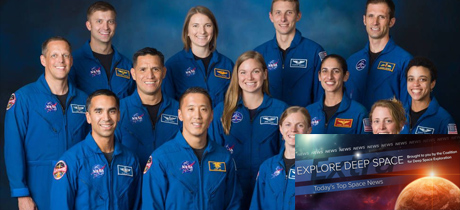In Today’s Deep Space Extra… NASA will welcome the graduation of 11 astronaut candidates on Friday, the first to join the corps under the Artemis initiative to return to the surface of the Moon with human explorers. Japan’s Hayabusa2 may take up a new mission after dropping off samples from its asteroid mission to Ryugu.
Human Space Exploration
NASA’s astronaut class for the ‘Artemis’ age graduates Friday. How to watch live
Space.com (1/9): NASA will mark the graduation of its 22nd class of astronaut candidates Friday morning in ceremonies at the NASA Johnson Space Center (JSC) that will be streamed live and broadcast over NASA TV. The class includes six men and five woman, who were joined for two years of basic training by two Canadian Space Agency astronaut candidates, a woman and man. All are eligible for Artemis, NASA’s initiative to carry out an accelerated human return to the Moon in 2024 as well as duty aboard the six person International Space Station (ISS). More than 18,000 U.S. citizens, a record, applied for the NASA positions, which were filled in 2017.
NASA TV coverage set for three spacewalks in January
NASA (1/8): NASA plans to resume spacewalks soon to complete a more efficient Lithium ion for older nickel hydrogen battery exchange and a thermal control system upgrade of the Alpha Magnetic Spectrometer (AMS), both outside the International Space Station (ISS). NASA astronauts Jessica Meir and Christina Koch will reprise their first all-woman spacewalk in October for the battery exchange spacewalks planned for January 15 and 20. NASA astronaut Drew Morgan will join with European Space Agency (ESA) astronaut Luca Parmitano on January 25 for the AMS work begun in November and December.
After mishap with Boeing spacecraft, NASA faces a dilemma
Coalition Member in the News – Boeing
Washington Post (1/9): NASA and Boeing face a potentially difficult decision as they investigate what happened during the December 20 launch of the company’s orbital test flight with the CST-100 Starliner. The capsule, along with SpaceX’s Crew Dragon, are striving to obtain certification to begin the regular transportation of astronauts to and from the International Space Station (ISS), potentially this year. Shortly after the December liftoff, the Starliner experienced a yet to be explained timer issue that prevented the uncrewed spacecraft from raising its orbit to carry out an automated docking with the ISS. The investigation could determine whether the test flight must be re-launched.
NASA TV coverage set for three spacewalks in January
NASA (1/8): NASA plans to resume spacewalks soon to complete a more efficient Lithium ion for older nickel hydrogen battery exchange and a thermal control system upgrade of the Alpha Magnetic Spectrometer (AMS), both outside the International Space Station (ISS). NASA astronauts Jessica Meir and Christina Koch will reprise their first all-woman spacewalk in October for the battery exchange spacewalks planned for January 15 and 20. NASA astronaut Drew Morgan will join with European Space Agency (ESA) astronaut Luca Parmitano on January 25 for the AMS work begun in November and December.
Space Science
Mars loses its water even faster than anyone thought
Space.com (1/9): New research may help to explain why neighboring Mars is a cold dry desert, though the surface shows evidence of a past stream flow and pooling of water. The transition suggests that the Red Planet may have hosted some form of life long ago. Prevailing theories suggest the Martian atmosphere with moisture was stripped away by the solar wind, thanks to the absence of a global magnetic field. A study led by a French researcher using data from the European Space Agency’s (ESA) Mars Express orbiter suggests that during storm periods, the Martian atmosphere becomes super saturated with the moisture that is available now, making it even more vulnerable. The findings were published in the journal Science.
Hayabusa2 asteroid probe to take up new mission
The Japan News (1/10): According to the report, Japan’s Hayabusa 2 asteroid sample return mission could be assigned a news destination after dropping off samples gathered from the surface and subsurface of Ryugu last year. The probe began its journey back to Earth in November and is expected to flyby for the drop off late this year.
SpaceX, astronomers working to address brightness of Starlink satellites
SpaceNews.com (1/8): SpaceX has expressed a willingness to work with the astronomy community to address concerns over the brightness the company’s growing Starlink fleet of small communication satellites could have on observations. One of 60 Starlight small sats launched by SpaceX on January 6, DarkSat, received a dark outer coating to assess its effectiveness in not reflecting light. However, many professional astronomers remain skeptical of how quickly their concerns can be addressed. The issue was a topic at this week’s 235th meeting of the American Astronomical Society (AAS) in Honolulu.
Other News
Dream Chaser on track for 2021 cargo mission, crew within 5 years
Coalition Member in the News – Northrop Grumman
Spacepolicyonline.com (1/9): Sierra Nevada Corp is preparing to join Northrop Grumman and SpaceX in launching NASA contracted resupply missions to the International Space Station (ISS) in 2021 with the winged Dream Chaser lifting body. Sierra’s will be the only cargo service, however, capable of returning experiments and equipment to Earth with a runway landing. The Colorado based company plans to be capable of launching astronauts to low Earth orbit with Dream Chaser within five years, while it pursues a range of roles in NASA’s effort to return to the surface of the Moon with human explorers.
NASA, aerospace companies look to crowdsourcing companies like HeroX to tackle problems
Florida Today (1/9): Enterprises like HeroX are working with agencies like NASA and aerospace companies to provide a platform for people from all over to offer insight and/or a solution to challenging problems in the aerospace field.

